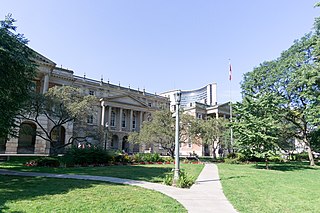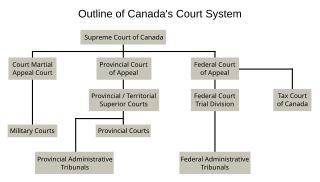
A judge is a person who presides over court proceedings, either alone or as a part of a panel of judges. The powers, functions, method of appointment, discipline, and training of judges vary widely across different jurisdictions. The judge is supposed to conduct the trial impartially and, typically, in an open court. The judge hears all the witnesses and any other evidence presented by the barristers of the case, assesses the credibility and arguments of the parties, and then issues a ruling on the matter at hand based on his or her interpretation of the law and his or her own personal judgment. In some jurisdictions, the judge's powers may be shared with a jury. In inquisitorial systems of criminal investigation, a judge might also be an examining magistrate.

The Supreme Court of Canada is the highest court of Canada, the final court of appeals in the Canadian justice system. The court grants permission to between 40 and 75 litigants each year to appeal decisions rendered by provincial, territorial and federal appellate courts. Its decisions are the ultimate expression and application of Canadian law and binding upon all lower courts of Canada, except to the extent that they are overridden or otherwise made ineffective by an Act of Parliament or the Act of a provincial legislative assembly pursuant to section 33 of the Canadian Charter of Rights and Freedoms.
The Courts of England and Wales, supported administratively by Her Majesty's Courts and Tribunals Service, are the civil and criminal courts responsible for the administration of justice in England and Wales.
In common law systems, a superior court is a court of general competence which typically has unlimited jurisdiction with regard to civil and criminal legal cases. A superior court is "superior" relative to a court with limited jurisdiction, which is restricted to civil cases involving monetary amounts with a specific limit, or criminal cases involving offenses of a less serious nature. A superior court may hear appeals from lower courts.
Court dress comprises the style of clothes prescribed for courts of law, and for royal courts.
Small-claims courts have limited jurisdiction to hear civil cases between private litigants. Courts authorized to try small claims may also have other judicial functions, and go by different names in different jurisdictions. For example, it may be known as a county or magistrate's court. These courts can be found in Australia, Brazil, Canada, England and Wales, Hong Kong, Ireland, Israel, New Zealand, Philippines, Scotland, Singapore, South Africa and the United States.

Osgoode Hall is a landmark building in downtown Toronto, Ontario, Canada. The original 2 1⁄2-storey building was started in 1829 and finished in 1832 from a design by John Ewart and W. W. Baldwin. The structure was named after William Osgoode, the first Chief Justice of Upper Canada.

The court system of Canada forms the judicial branch of government, formally known as "The Queen on the Bench", which interprets the law and is made up of many courts differing in levels of legal superiority and separated by jurisdiction. Some of the courts are federal in nature, while others are provincial or territorial.
Paul James Cosgrove,, is a former Canadian jurist as well as a former politician.

The Federal Court is a Canadian trial court that hears cases arising under certain areas of federal law. The Federal Court is a lower court with nationwide jurisdiction.
The courts of Northern Ireland are the civil and criminal courts responsible for the administration of justice in Northern Ireland: they are constituted and governed by Northern Ireland law.
The Ontario Court of Justice is a provincial court of record for the Canadian province of Ontario. The court sits at more than 200 locations across the province and oversees matters relating to family law, criminal law, and provincial offences.

The Court of Queen's Bench of Alberta is the superior court of the Canadian province of Alberta. The Court of Queen's Bench of Alberta in Calgary was relocated to the Calgary Courts Centre in 2007. The Court of Queen's Bench has been located at the Law Courts building in Edmonton since the 1970s.

The Supreme Court of Georgia is the highest judicial authority of the U.S. state of Georgia. The court was established in 1845 as a three-member panel. Since 1896, the justices have been elected by the people of the state. The justices are currently elected in statewide non-partisan elections for six-year terms, with any vacancies filled through an appointment by the Governor.
The provincialandterritorial courts in Canada are local trial "inferior" or "lower" courts of limited jurisdiction established in each of the provinces and territories of Canada. These courts typically hear criminal, civil, family, traffic, and bylaw cases. Unlike the superior courts of Canada, the jurisdiction of the provincial courts is limited to those matters which are permitted by statute. They have no inherent jurisdiction. Appeals of provincial court decisions are usually heard by the superior court of the province.

The Supreme Court of Ontario was a superior court of the Canadian province of Ontario. Created in 1881 pursuant to the Ontario Judicature Act (1881), the Supreme Court of Ontario had two branches: the High Court of Justice Division and the Appellate Division. The Supreme Court of Ontario was a Section 96 court with inherent jurisdiction.
A master is a judge in the courts of England and in numerous other jurisdictions based on the common law tradition. A master's jurisdiction is generally confined to civil proceedings and is a subset of that of a justice. Masters are typically involved in hearing trials, case management, and in some jurisdictions dispute resolution or adjudication of specific issues referred by judges.
The Supreme Court of Prince Edward Island is the superior court of the Canadian province of Prince Edward Island.








